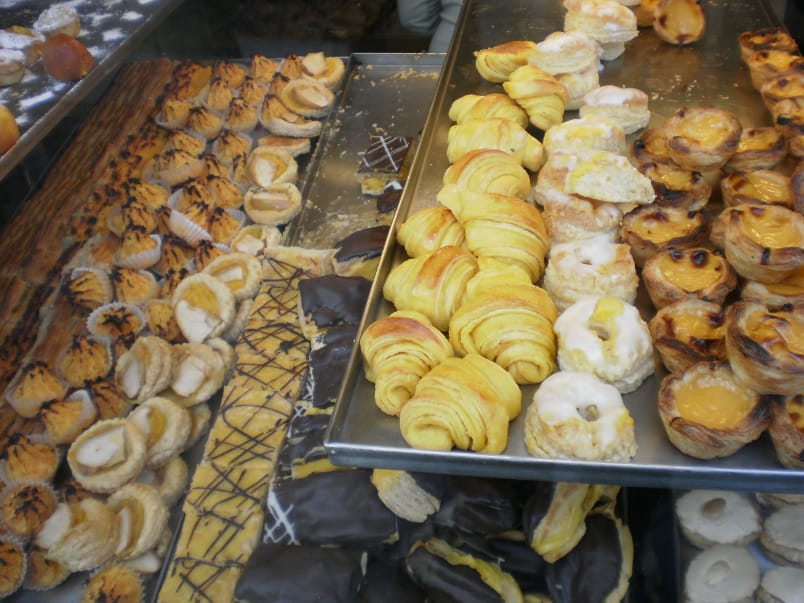Traditional Food of Portugal - Part I National
Explore Portugal's culinary journey—couvert, bacalhau, Vinho Verde, and iconic Pastel de Nata. Dive into regional delights from Porto to Algarve.

This is the first of a four part series on the traditional food of Portugal. It starts with an overview of some national favorites. Articles to follow over the next week will feature Northern Portugal and Porto, Lisbon, and The Algarve.
National Favorites
Couvert is a variety of pre-meal snacks that are brought to your table as soon as you are seated in most Portuguese restaurants. The selection is usually wonderful crusty Portuguese bread, olives (often with bits of garlic and herbs), butter, and sometimes sardine pate. There may be additional items like small cheeses, or carrots in olive oil and garlic. You will be charged for each item that you eat. The prices are usually very reasonable, but be certain to say no thank you and ask to have them removed if you do not want to be charged for them.
Portuguese bread is served with every meal. The loaves are many shapes and sizes made with a variety of flours. All are wonderful eaten with butter or olive oil. They are perfect for soaking up the broths in clams, cataplana, fish stew, etc.
Flor de sal is hand harvested sea salt that captures the first layer of salt before it sinks. You can get flor de sal with a variety of herbs added in many local or specialty markets. I usually bring a few types home from Portugal and use them throughout the year as my table salt.
Conserva de cenoras is a savory and spicy carrot appetizer made with black olives and herbs. Much like the hot carrots of Baja California but without the heat.
Caldo Verde seems to be the national soup of Portugal made with potato, shredded kale, and chunks of chouriço (chorizo) sausage. It tastes great all year but is especially comforting on a cool or rainy day.
Sopa do Dia, soup of the day, is usually a puree of vegetables most commonly featuring carrots or green beans. The base to thicken the soup is often pureed potatoes. Some restaurants will call this vegetable soup on their English language menu. It in no way resembles the Campbell’s vegetable soup of our childhood. It makes a wonderful quick lunch with some crusty Portuguese bread.
Caldeirada is a fish soup made of water, tomatoes, onions, garlic and other ingredients that traditionally will depend on the fisherman’s catch of the day. Cozido à Portuguesa is a thick stew made with meat and vegetables.
Bacalhau, or salt cod, is served throughout Portugal. Each region has their favorite ways of preparing it. Two of the most popular are bacalhau à Gomes de Sã (salted cod, potatoes and onions topped with eggs and onions) and bacalhau à bras (salt cod, potato, onion and scrambled eggs). Neither looks a whole lot better than they sound. But they are surprisingly tasty. The Portuguese have a knack for turning the unappetizing looking bacalhau into hearty and satisfying main dishes.
Cheese is seldom included as an ingredient in traditional Portuguese cooking. However the country has a wide selection of very good cheeses. It is usually eaten as part of the couvert or after the meal. Queijo São Jorge is a cheese made with cow’s milk and is one of my favorites. Other favorites are Quejo de Castelo Branco and Quejo Sao Jorge. Check the local market for a wide selection of cheeses made from cow and sheep milk.
Vinho Verde literally translates as green wine. However, it is white not green in color. Green refers to the fact that it is not an aged wine. Green wines are only produced in the north of Portugal and are usually slightly sparkling. I love this wine. It is especially good with Ameijoas Bolhão Pato, steamed clams with garlic. Port wine is produced in the Douro region. Vinho da Madeira, similar to sherry, is a regional wine produced in Madeira.

Sweets may be the best part of Portuguese cuisine! Do not expect the U.S. dessert offered on the menu as an individual dessert and yet made to serve four people! Sweets in Portugal are most often small dishes providing a few bites. They are eaten for breakfast, afternoon snacks, with coffee on the way home from work, or any time of the day. Egg-based recipes are the most prevalent type of sweet in Portugal.
The Pastel da Nata, a custard tart, can be found all over Portugal, but is most popular in central and south Portugal. Called Pastel de Nata in the south, it is called Pasteis de Nata in other parts of the country. I love this tart served slightly warmed and sprinkled with cinnamon.
Other popular desserts are arroz doce, rice pudding, and pudim flã, a caramel custard similar to Spanish flan. Cakes and other pastries are also popular in Portugal.
After dinner in a restaurant there is usually a small selection of pies or cakes and a large variety of ice cream concoctions. I find it interesting that in a country that consumes amazing tasting sweets all day long the dessert menus in restaurants are usually quite lacking. For your desserts stop at one of the many sweet (doce) shops to be found on almost every block in Portugal. In downtown Lisbon they are often two or three to a block.
Read more about the food or Portugal and try your hand at cooking up some favorites with “The Food of Portugal” or “The New Portuguese Table: Exciting Flavors from Europe’s Western Coast“. .




